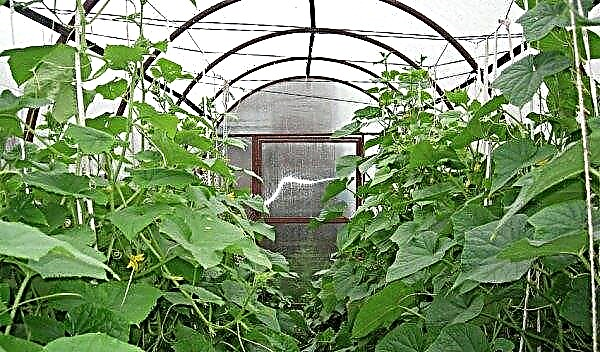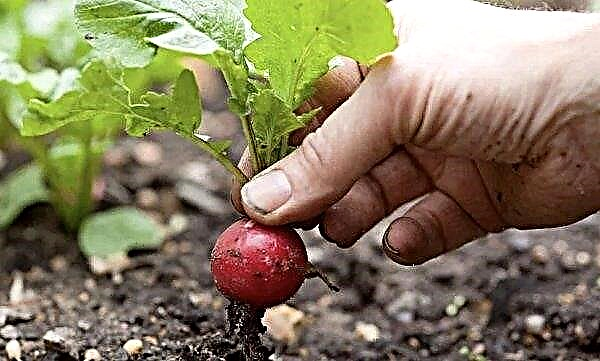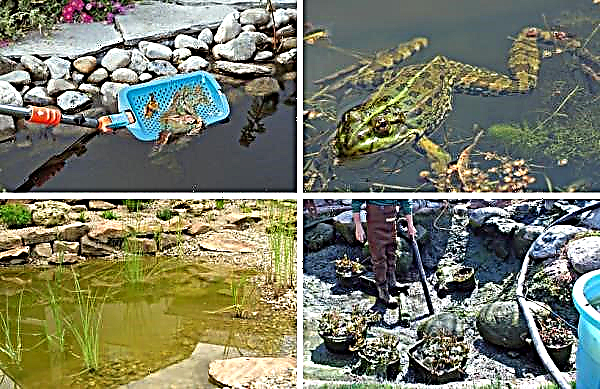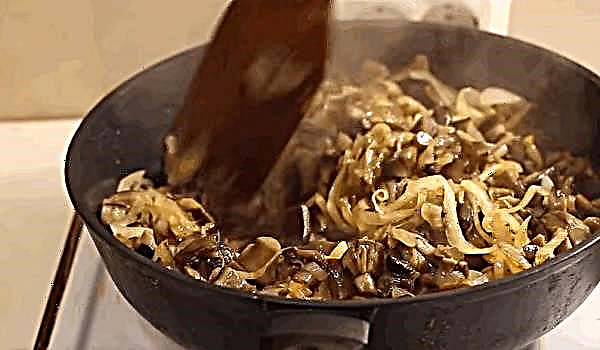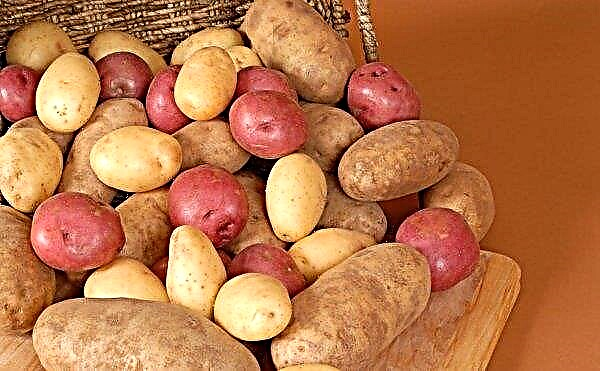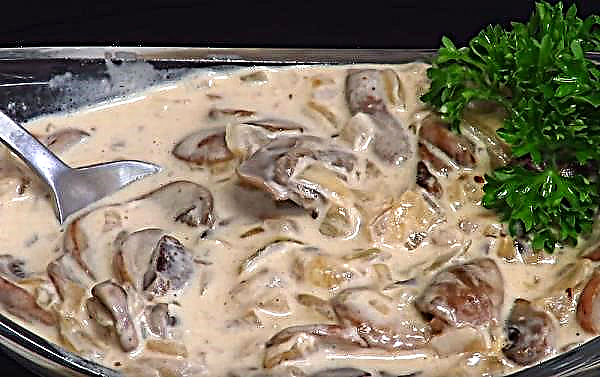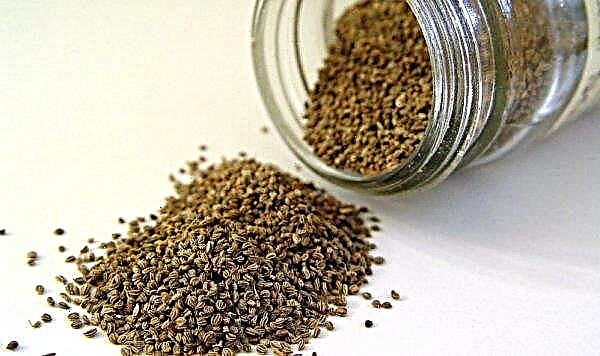Potato refers to vegetables that are usually harvested for future use. This contributes to the nutritional value of the vegetable and good keeping quality. It is better to store the vegetable in a separate room - a vegetable store, but most do not have the opportunity to create such conditions. From the article you will learn how to store potatoes in a home refrigerator.
What varieties are best stored?
Stability of the crop depends on many factors, the most often affected by the soil and climatic conditions and microclimate on the site during the growing period of the vegetable.
The main condition for long-term storage of tubers is a dense and holistic peel, which is a protective barrier to pulp from damage by fungi and bacteria. In addition, moisture-friendly varieties are not able to be stored for long. Due to the abundant accumulation of water, the flesh becomes watery, which eventually starts the process of rotting.Did you know? Potatoes became the prototype of a toy popular in the late 1940s, called Mr. Potato Head - a potato tuber with eyes, hands, hat, boots and other accessories.
Varieties that are more resistant to diseases and pests are distinguished by better stagnation; therefore, if a variety is not resistant to them, both individual tubers and the entire crop will die in a couple of months after harvest.
Better stored late potatoes with a long growing season, characterized by natural resistance to weather conditions and biotic factors.
Among them, the following varieties are considered popular and in demand among gardeners:
- Picasso
- Crane;
- Asterix;
- Blue;
- Lorch;
- Atlant
- Vesnyanka.
How to store potatoes in the refrigerator?
A household refrigerator is one of the places in the house for storing food. However, not everyone knows whether it is possible to keep potatoes in such conditions for a long time, and after how much it will begin to deteriorate. The most suitable for these purposes is the lower compartment of the refrigerator, specially created for storing fresh vegetables. However, before you put the potatoes there, it should be prepared in advance.
Why it is impossible to store previously harvested tubers whole without preliminary manipulations? The fact is that in the refrigerator there is an interaction of low temperatures with high humidity, which affects the potato ambiguously. On the one hand, this microclimate provides an obstacle to the drying out of fruits and the preservation of pulp, but with prolonged exposure it activates the kidneys of tubers. In addition, tubers are often susceptible to damage, which in such conditions causes instant rotting of the pulp.
Peeled Potato Storage
To reduce the loss of precious time, many housewives harvest peeled potatoes for future use. Often, peeled tubers are stored in their entirety as a universal preparation for dishes.
There are two ways to preserve peeled potatoes:
- Wet. Peeled potatoes are immersed in a deep container with cold water, and then transferred to the refrigerator. Potatoes are stored in water in their entirety in order to avoid leaching of starch from the fetal tissues, which threatens to impair the aromatic and taste qualities of the fruits. To improve preservation in water (3-5 liters), dip a slice of lemon or dissolve 0.5 g of citric acid.
Important! Potato water is not recommended for cooking or stewing in the future. During the soaking, residues of nitrates and toxins, derivatives of intensive agrotechnics of growing plants, are released from the tuber tissues.
- Dry. Thoroughly peeled tuber is dried, and then portioned in plastic bags or cling film. In this form, the fruits are stored in the freezer, while the tubers are crushed to the required size. In the future, the workpiece is not subject to defrosting, since after it the vegetable instantly loses its meatiness and juiciness. Frozen and chopped tubers are subjected to heat treatment before defrosting.
How to save a boiled vegetable?
Boiled potatoes are more difficult to keep in the refrigerator. This is due to the natural decay of tissues and cells, which affects all thermally processed foods. Dishes from chopped tubers are stored in airtight containers or food containers (pan, tray). They are transferred to the refrigerator immediately after cooling, since the duration of the preservation of the fruits depends on this.
Whole boiled potatoes are stored only in sealed containers or in cling film, and always in the peel. Under the influence of oxygen, the fruits instantly wind off and darken, which significantly shortens their preservation. At the same time, during long-term storage, boiled tubers become sticky, which makes their suitability for consumption doubtful.
Storage time
Boiled or stewed potatoes, according to sanitary norms and rules, should be stored for no more than 2 days, while the temperature in the refrigerator should be no more than + 5 ° С. If you want to extend its shelf life up to 3-4 days, the temperature in the refrigerator must be lowered to 0 ... + 4 ° С. At the end of these periods, the tubers are disposed of, even if they did not show distinct signs of spoilage (unpleasant odor or uncharacteristic color).
It is recommended that the vegetable be stored in water for no more than 2 days, however, if stored in the refrigerator, it can be extended to 4 days. During this, you need to change the water at least 1 time per day. As you save, starch accumulates in the fluid, which creates a breeding ground for the development of pathogenic bacteria and fungi. During freezing, tubers can be stored for up to 6 months, but it is forbidden to defrost them.
If you want to keep the vegetable unpeeled, you should try hard. It is carefully sorted out, discarding damaged tubers. This increases the shelf life of tubers at times. Despite the complexity of saving relative to other methods, such fruits have a more saturated taste and aroma, which makes them practically indistinguishable from fresh potatoes.
In this case, the tubers can be laid for:Important! The deadline for saving potatoes in the refrigerator is the second half of February. After this period, the kidneys are activated on the tubers, which will lead to the development of sprouts.
- short-term storage - the temperature is maintained within +6 ... + 10 ° С, this contributes to their conservation for 3 months;
- long-term storage - the vegetable is kept at 0 ... + 4 ° C, which preserves its freshness for up to 6 months.
Other storage locations
The refrigerator is not the only place where you can store potatoes throughout the winter. In almost every house there is not only a suitable place for this, but also the corresponding temperature regime. In this case, be sure to protect the fruits from direct sunlight. Due to their effect in the tubers, a synthesis of dangerous toxins is observed, which render the crop unusable.
On the balcony
The balcony is not the best place for saving potatoes, since it is difficult to control the temperature and humidity, therefore they often use it only as a temporary storage until the average daily temperature drops within 0 ... + 5 ° С. Despite this, the fruits need to prepare a place. Potatoes are poured into trellised boxes, which are arranged in 2-3 tiers with a distance of 60–80 cm, but it is better to move the vegetable into separate wooden crates. In this case, he will not be able to lose properties, as well as undergo waterlogging.

On the loggia
A well-insulated loggia is the most common and convenient place that allows you to save vegetables for the winter. Here, a seasonal decrease in temperature to +10 ... + 15 ° С is often observed, which perfectly affects the preservation and keeping quality of tubers. Store potatoes on the loggia in well-ventilated wooden crates. Their bottom must be covered with straw, hay or sawdust - natural moisture regulators. When the temperature decreases to –20 ° С and lower, the tubers are covered with foam or a blanket from above, otherwise they may freeze. In such conditions, the crop can be preserved throughout the winter.
In the pantry
In the pantry, the temperature is several degrees lower than in living rooms. In addition, in this room, vegetables are protected from direct sunlight, which makes it possible to store potatoes in any vapor-tight container: from special boxes to linen bags. Under such conditions, the fruits need to be carefully sorted at least 1 time per month, the only way to ensure their safety for 6 months.
Did you know? For two centuries after the import of potatoes into Europe, the plant was considered poisonous. This is explained by the fact that the tubers were not recognized by the fruit, while the berries ripening from the flower were completely unsuitable and even harmful.
In the hall
If opportunities do not allow creating a separate place for potato tubers, you can store them in the hallway. At the same time, they need to be poured into a spacious wooden container, with ventilation gaps. In most cases, even at temperatures above + 20 ° C, potatoes in the hallway are successfully stored until mid-winter. After this, the stocks need to be viewed and sorted weekly, as well as periodically removed activated sprouts from the fruits. Otherwise, by the end of February they will become completely unusable.
In the basement
The basement is best suited for saving vegetables, including potatoes. However, at the same time, not only stable humidity (90–95%), but also good ventilation, as well as the required temperature (+5 ... + 10 ° С) should be maintained in the room. The tubers are stored in bulk in the basement, in trellis boxes or on shelves. At the same time, there should be a gap of at least 60 cm between each tier of potatoes, which helps prevent moisture from accumulating between the fruits. Subject to the optimal microclimate, in the basement you can save a harvest of 6-12 months.

A home refrigerator is one of the few places where conditions for long-term storage of vegetables are created. With it, you can extend the freshness of not only cooked, but also raw potato tubers. However, for this you need to take care of the preliminary preparation of vegetables.

